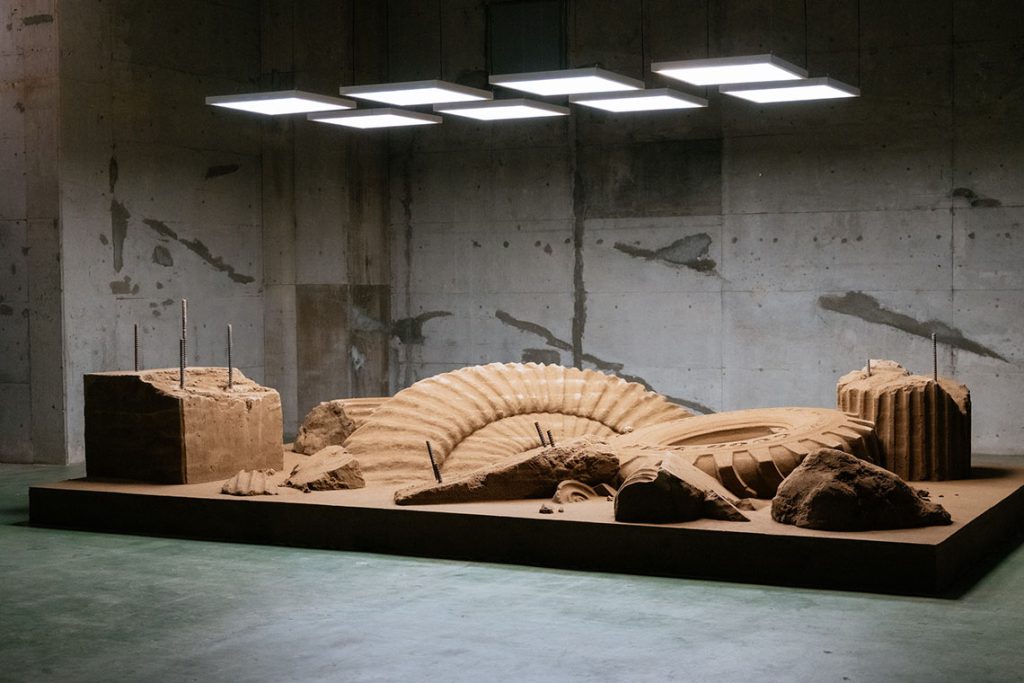For the occasion of Art Week Tokyo 2025, Future of Nostalgia features 20 participants from the AlUla Artist Residency programme over the past five years in an exploration of memory, time and our perception of reality.
Curated by Arnaud Morand and Ali Alghazzawi, and organised by Arts AlUla and the French Agency for AlUla Development (AFALULA), Future of Nostalgia borrows its name from Svetlana Boyrn’s eponymous book from 2021, and plays with the notion that nostalgia is both a constructive and destructive feeling that defines life. The exhibition brings together artists to investigate not only what is inherited from the past but also how the future is shaped, querying what will be forgotten or treasured, and looking at how we take these realisations into account as we move through time, as narratives are created and reshaped.
The move to bring the exhibition to Tokyo aligns with the residency’s global art ambitions of expanding international cultural conversations with the oasis city of AlUla. “For the Future of Nostalgia, it was important for us to build new ties with Asia and to connect with a scene that hasn’t yet been included in the programme,” notes Morand. “There is also a diplomatic dimension, because in 2025 Saudi Arabia and Japan have been celebrating the 70th anniversary of their international relations, which provides a meaningful context for this collaboration.”

The influence of AlUla is palpable through links to the oasis landscape, vast in both geological, sociological and historical references. “Artist have produced works there, creating some sort of palimpsest, where oral history, pre-Islamic civilisations, archaeological remnants and new architecture are in dialogue,” explains Morand. “They coexist with the intention to build a city of tomorrow through future forward-thinking, historical foundations and heritage programmes. The title of the exhibition is not just about melancholy or yearning but also a collective feeling that can shape the societies of today and potential futures.”
The tension of time and space is felt in Sarah Brahim’s two films, There Will Come Soft Rains (2025) and In Search of an Honest Map (2025). The artist uses the body to explore vulnerability and transformation in an expansive landscape, linking the human form with the environment, from sand to wind, as each movement transforms and leaves a trace on the other.
Abdessamad El Montassir’s installation, Sadra Kodia (2025), along with his sound piece Athar Dakira (2025), fills three walls of a dark space, immersing visitors in ghostly projections of gently moving trees. The work is a result of the artist’s research into memory, trauma and how these are passed on. The trees act as witnesses existing in time and space, holding onto memories of their surroundings but unable to express them.

Han Mengyun’s single-channel video, Gift (2025), translates the artist’s residency research. Inspired by the date palm fruits found in the oasis, Han merges oral histories, community and storytelling in a commentary on fertility with the aim of “reactivating” ancestral knowledge.
Palms also feature in Mohammad AlFaraj’s work, which draws upon storytelling and understanding of the land. The stop-motion work, The Date Fruit of Knowledge (2019), is flanked by palm leaves sourced locally in Japan. The video tells the tale of a bird seeking to know everything, yet this knowledge also comes with a hefty price in terms of solitude and disconnection from the world. The work prompts inspection of the desire to force time, reality – and senses of longing and excitement – as we seek answers about the future and the unknown.
For the exhibition, some artists from past residencies were offered to move from their research phase to a newly commissioned work specifically created for Tokyo. One of these works is Théo Mercier’s site-specific sand sculpture, LANDSCRIPT (2025). Created in situ, the piece delves into the transformation of the landscape and the traces of human presence. The sand and water installation will slowly dry up during the exhibition, leaving it vulnerable to change and disintegration and provoking thought around what we leave behind and the impermanence of existence.

Bianca Bondi’s new commission, It had something to do with the telling of time / the lunar calendar is 13 months / the folded house / the rhythm is internal / we have swallowed the clocks (2025) transforms materials through chemical reactions. The delicate silk tent installation is coated and surrounded by salt crystals, reminiscent of shelters created through childhood imagination as well as suggesting a place of refuge. The work draws from the desert’s ability to record and preserve the passage of time, while echoing the nomadic need to create temporary shelters, underlining the fragility of existence and the requirement to adapt. The work also invites viewers to ponder the passage of time and creates a space for imagination.
Morand affirms that, through the residency, “[the artist’s outcomes] feed the future of collecting and of institutions, an approach that is different from a traditional effort and very much from the land. It is not a project that broadcasts culture, but where everything is created from the ground up, a collection not built on the art market but with people understanding the location of AlUla to create artworks.” Overall, the exhibition highlights the AlUla Artist Residency’s commitment to artists’ careers beyond the research phase and the value of continued support beyond the residency, fostering new discussions across geographies and ways of thinking, while contributing to the larger global discourse.



